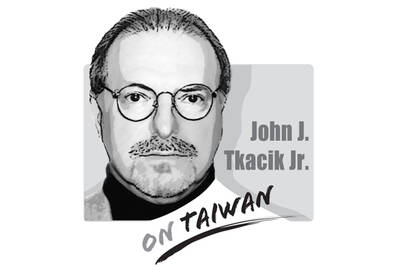Not long ago, the idea of dimming the sun would be considered either outlandish or taboo.
A new analysis reveals that neither of those things is entirely true anymore, as the funding going into the field of solar geoengineering — techniques that aim to soothe the symptoms of climate change by reflecting more of the sun’s heat back into space — is increasing as rapidly as the public discourse around its research and development.
A funding tracker by SRM360, a nonprofit that monitors the emerging technologies, provides the first comprehensive view of the money flows around solar radiation modification (SRM).

Illustration: Yusha
Here is what to take note of:
In the five years between 2020 and last year, US$112.1 million was allocated to research and building awareness. Going forward, US$92.6 million has been committed for this year through 2029, suggesting that this upward trend is set to continue.
Although it is expanding, the size of the field is still tiny. As of the end of last year, a total of US$191.7 million of verifiable funds has been allocated to solar geoengineering. To put that into context, investments in the energy transition exceeded US$2 trillion last year.
For a closer comparison, a single Hollywood movie often costs more than what has been put toward SRM: Barbie, director Greta Gerwig’s 2023 blockbuster, reportedly had a combined production and marketing budget of US$295 million.
Despite that, it is vital to closely examine the money flowing toward the technologies. As SRM360 states in its report, current funding has a “major influence on the methods used to assess SRM, what questions are being asked and in which countries, and the kinds of governance being built around it.”
The British government is a world leader in the field, thanks in part to a £56.8 million (US$75.63 million) climate cooling research program. The real big dogs are major philanthropies, which have provided about 48 percent of SRM funding through to the end of last year. Many of these philanthropic ventures have roots in the worlds of tech and finance.
Open Philanthropy, the SRM outlays of which exceed those of the EU, was launched by Facebook cofounder Dustin Moskovitz. Larry Birenbaum — formerly a senior vice president at Cisco Systems Inc and currently a partner at the LAD Climate Fund, which supports the research and advocacy of SRM — also sits on the board of SRM360.
That is not a surprise: Philanthropies often step in where governments cannot justify spending, and a simple, futuristic technique such as SRM no doubt has unique appeal to the Silicon Valley cohort. However, when private organizations are supporting most of the research output, the governance gap becomes even more important to close.
Commercial investment accounts for considerably less, about US$17.7 million in total — or just 9 percent — but should be watched closely to see if an injection of US$15 million in venture capital is a one-time event or the start of a trend.
Putting SRM research into the hands of profit-seeking enterprises raises all sorts of troubling prospects. For example, if a company started deploying SRM, would governments be equipped to hold it liable for any unintended consequences? If it went bust, would the world be exposed to rapid global warming, also known as termination shock?
Likewise, the vast majority of investment is in the global north — with SRM researchers and organizations in developed countries receiving 50 times more in funding than the global south. Developing countries are at the front line of climate change and have the most to gain or lose from any attempts to turn down the global thermostat, so their perspectives are key.
Excluding them from research, even at this early stage, means important questions would go unanswered.
From the altering of weather patterns to the potential of termination shock, any eventual deployment of such geoengineering technologies would have profound effects on the entire planet. While research is key to filling the huge gaps in understanding the risks and benefits, governments must ensure that the science is done responsibly and answers the questions that are most in the public interest. Transparency is therefore essential to ensure high ethical standards and prevent misinformation.
Take the UK’s climate cooling research program. The funding is coming from the Advanced Research and Invention Agency (ARIA), a government body, and would be used to pay for a broad spectrum of research, including modeling the climate responses, observing natural processes and, where appropriate, small outdoor experiments.
However, seeds of a conspiracy theory have already been planted. ARIA has been described as a “secretive” unit, while journalist Jim Waterson wrote on social media platform Bluesky that the government “policy” that has come up more than any other during his interviews with Londoners is British Prime Minister Keir Starmer’s “plan to dim the sun.”
The government published a position on solar geoengineering in 2020: “The Government is not deploying SRM, and has no plans to do so.” Nevertheless, many scientists and advocates are concerned about a “slippery slope” toward deployment.
Meanwhile, although ARIA’s climate cooling program has an independent oversight committee and states commitments to good governance, it is not subject to Freedom of Information laws. That is to enable the unit operational freedom to undertake high-risk, novel projects, yet such an approach does not lend itself to building or maintaining trust.
Although SRM360’s analysis is a step toward better transparency, several organizations did not respond to the nonprofit’s requests for information. That, alongside US$1.1 million of anonymous donations, raises serious questions about public oversight of the massively consequential field.
One of the biggest concerns is that the fossil fuel industry could use SRM as a way of avoiding the hard work of decarbonization — the only way to solve climate change. SRM360 said that it found no evidence of fossil fuel interests promoting or paying for SRM research, but without complete transparency it is impossible to know for certain.
This columnist shares the same view as many scientists doing valuable research: the hope that it is never deployed. It is not a climate solution, but it is clear that the field is progressing. With many difficult conversations ahead, even those who find SRM distasteful should push for rigorous, transparent research, clear communication and keep their eyes on the money.
Lara Williams is a Bloomberg Opinion columnist covering climate change. This column reflects the personal views of the author and does not necessarily reflect the opinion of the editorial board or Bloomberg LP and its owners.

Elbridge Colby, America’s Under Secretary of Defense for Policy, is the most influential voice on defense strategy in the Second Trump Administration. For insight into his thinking, one could do no better than read his thoughts on the defense of Taiwan which he gathered in a book he wrote in 2021. The Strategy of Denial, is his contemplation of China’s rising hegemony in Asia and on how to deter China from invading Taiwan. Allowing China to absorb Taiwan, he wrote, would open the entire Indo-Pacific region to Chinese preeminence and result in a power transition that would place America’s prosperity
A few weeks ago in Kaohsiung, tech mogul turned political pundit Robert Tsao (曹興誠) joined Western Washington University professor Chen Shih-fen (陳時奮) for a public forum in support of Taiwan’s recall campaign. Kaohsiung, already the most Taiwanese independence-minded city in Taiwan, was not in need of a recall. So Chen took a different approach: He made the case that unification with China would be too expensive to work. The argument was unusual. Most of the time, we hear that Taiwan should remain free out of respect for democracy and self-determination, but cost? That is not part of the usual script, and
All 24 Chinese Nationalist Party (KMT) lawmakers and suspended Hsinchu Mayor Ann Kao (高虹安), formerly of the Taiwan People’s Party (TPP), survived recall elections against them on Saturday, in a massive loss to the unprecedented mass recall movement, as well as to the ruling Democratic Progressive Party (DPP) that backed it. The outcome has surprised many, as most analysts expected that at least a few legislators would be ousted. Over the past few months, dedicated and passionate civic groups gathered more than 1 million signatures to recall KMT lawmakers, an extraordinary achievement that many believed would be enough to remove at
Behind the gloating, the Chinese Nationalist Party (KMT) must be letting out a big sigh of relief. Its powerful party machine saved the day, but it took that much effort just to survive a challenge mounted by a humble group of active citizens, and in areas where the KMT is historically strong. On the other hand, the Democratic Progressive Party (DPP) must now realize how toxic a brand it has become to many voters. The campaigners’ amateurism is what made them feel valid and authentic, but when the DPP belatedly inserted itself into the campaign, it did more harm than good. The